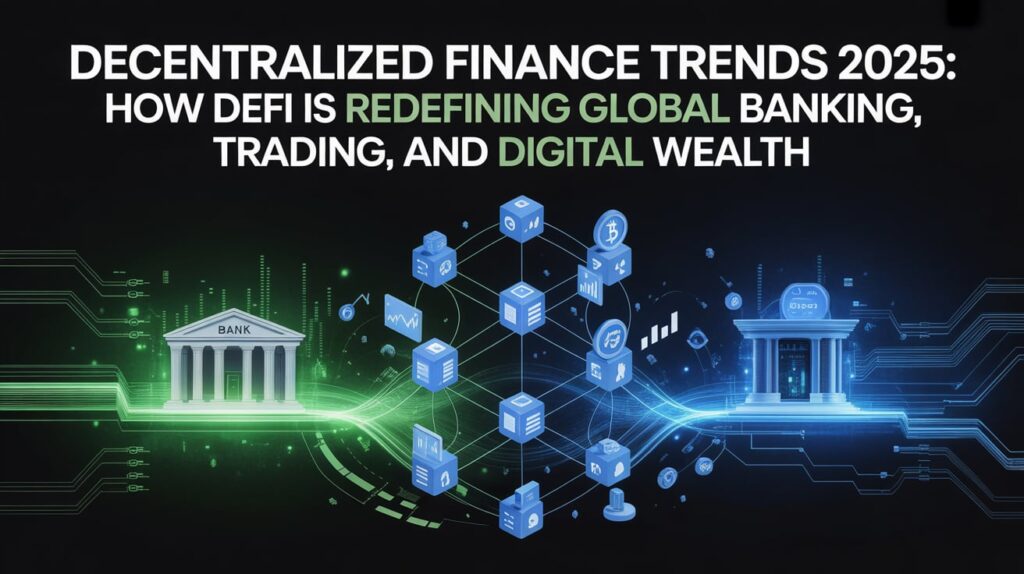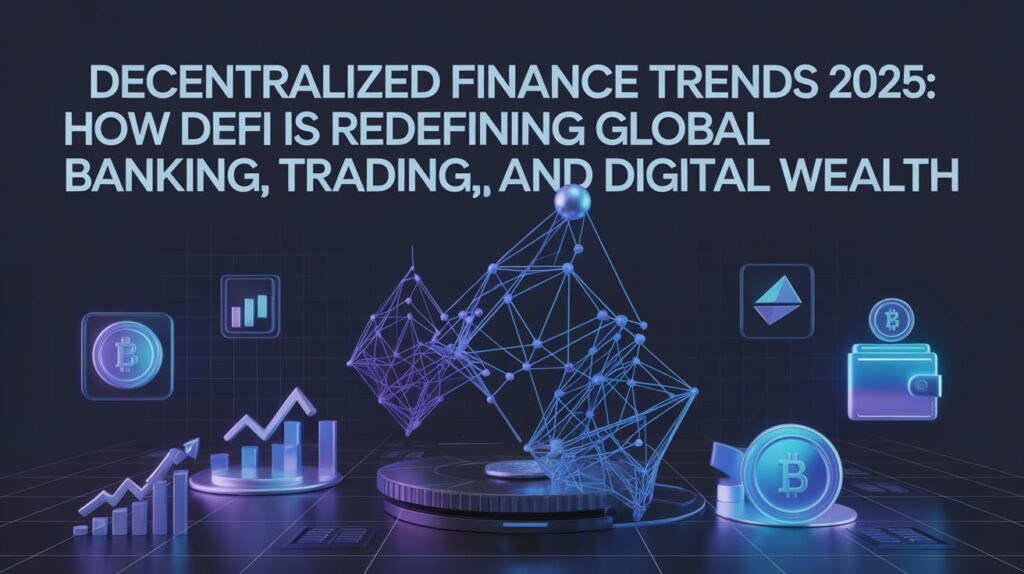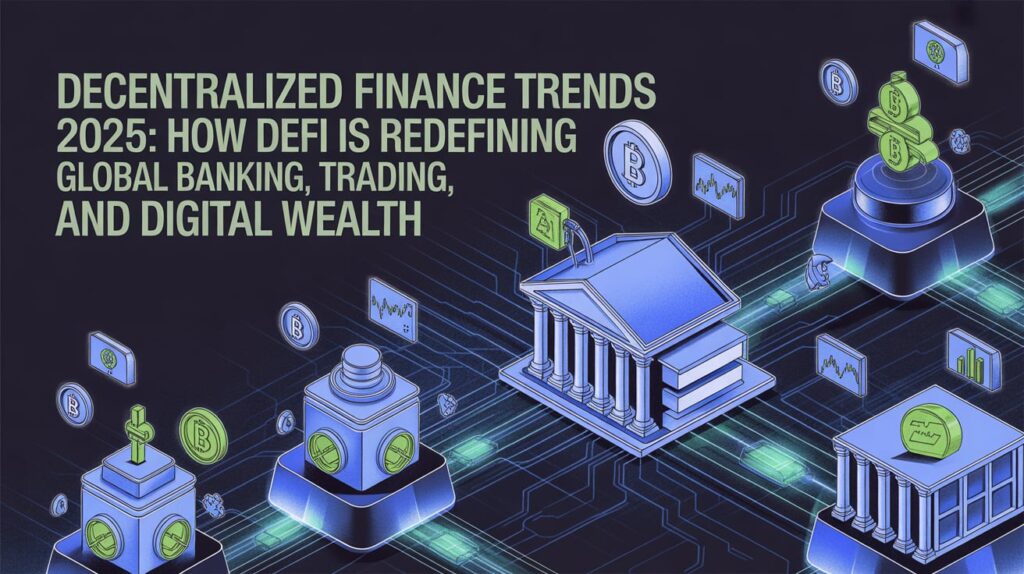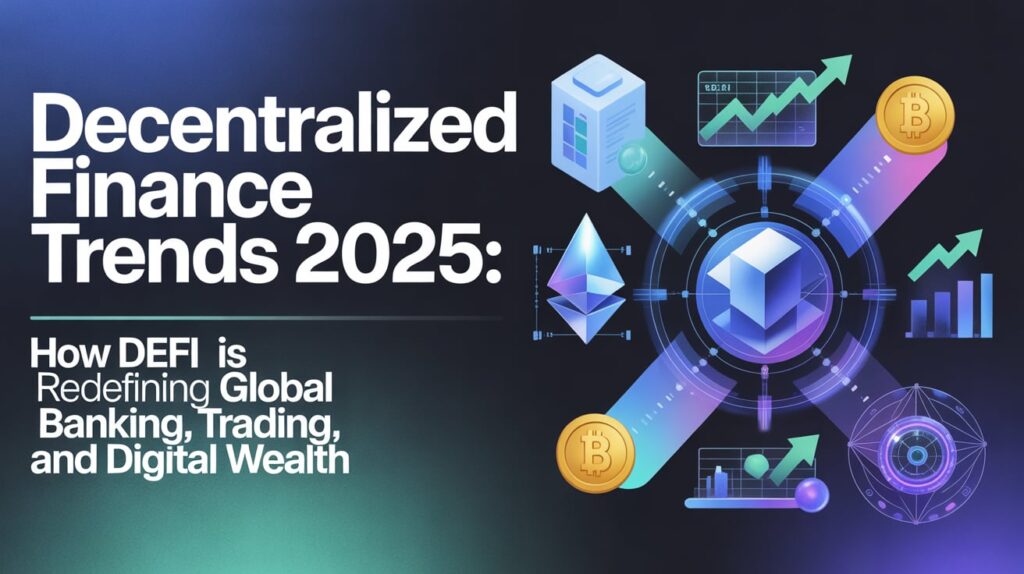🏦 Decentralized Finance Trends 2025: How DeFi Is Redefining Global Banking, Trading, and Digital Wealth

Introduction: The DeFi Revolution, Five Years In
When DeFi (Decentralized Finance) exploded in 2020, it was considered a fringe experiment — a playground for tech enthusiasts and crypto whales.
Fast-forward to 2025, and DeFi has evolved into a full-fledged financial ecosystem worth over $300 billion in total value locked (TVL).
From decentralized lending and liquid staking to real-world asset tokenization and institutional DeFi, the industry has matured beyond its wild west beginnings. It’s no longer about “yield farming” or “fast APY.” It’s about creating a borderless, programmable financial world that anyone can access — without banks, brokers, or middlemen.
Let’s explore the biggest DeFi trends of 2025, how they’re reshaping global finance, and where the next trillion-dollar opportunities might emerge.
🌐 1. The State of DeFi in 2025
DeFi now sits at the intersection of blockchain, AI, and Web3 infrastructure.
According to Messari’s 2025 Q1 report, over 450 million users interact with decentralized protocols monthly — a tenfold increase since 2022.
📈 Key Stats:
-
Total Value Locked (TVL): $312 billion (up 70% YoY)
-
Top Blockchains: Ethereum (L2 dominant), Solana, Avalanche, and Polygon zkEVM
-
Top Sectors: Lending (30%), DEXs (25%), Liquid Staking (20%), Real-World Assets (15%)
-
Average DeFi User Age: Between 25 – 38 years old
DeFi is officially entering mainstream finance, not just crypto culture.
💡 2. Institutional DeFi Adoption
Banks once dismissed DeFi as “unregulated chaos.” Now they’re integrating with it.
Major financial institutions like JPMorgan, HSBC, and Societe Generale are testing on-chain settlement systems.
The Tokenized Treasury Market — bonds and securities issued on Ethereum or Avalanche — is becoming a legitimate yield source for institutional investors.
Why Institutions Are Joining DeFi:
-
24/7 Settlement: No waiting for bank hours.
-
Transparency: Instant auditability of assets.
-
Liquidity: Open-market access without gatekeepers.
-
Efficiency: Smart contracts replace paperwork.
The future of finance won’t replace banks — it will merge them with blockchain.
🧱 3. The Layer-2 Expansion: Scaling DeFi

Gas fees once priced users out of Ethereum.
Now, Layer-2 (L2) networks like Arbitrum, Optimism, and Base process over 60% of DeFi transactions.
Key Innovations:
-
EIP-4844 (Proto-Danksharding): Cut roll-up costs > 80%.
-
Cross-Chain Bridges 2.0: Safer, verified liquidity transfer.
-
Unified Wallets: Seamless navigation between L1 & L2 apps.
2025’s DeFi users enjoy faster, cheaper, and eco-friendlier transactions — crucial for global scale.
💰 4. Real-World Asset (RWA) Tokenization
RWAs are the breakout trend of 2025.
Projects like Maple Finance, Centrifuge, and Ondo Finance are turning treasury bills, corporate bonds, and real estate into yield-bearing blockchain tokens.
Benefits:
-
Stable Yields: 3-6% returns, lower volatility than crypto lending.
-
Transparency: Proof of reserve on-chain.
-
Accessibility: Retail investors can own fractions of institutional assets.
Real-World Assets are transforming DeFi from speculative finance into a credible global investment system.
🧠 5. AI + DeFi: The Smart Finance Revolution
Artificial intelligence is now fused into blockchain analytics.
AI agents manage risk, lending, and portfolio optimization autonomously.
Examples:
-
Fetch.ai (FET) integrates AI bots that auto-rebalance DeFi portfolios.
-
SingularityNET builds AI oracles to forecast market volatility.
-
Aave AI Suite: Predictive loan health monitoring reduces liquidations.
By 2025, AI-driven DeFi isn’t hype — it’s infrastructure.
📉 6. DeFi 2.0 and the End of Unsustainable Yields
The early DeFi era was a gold rush of 1000% APY and flash-farm schemes.
2025 is about “real yield.”
Protocols now distribute revenue from fees, not inflated tokens.
Examples:
-
GMX v2 shares trading fees with liquidity providers.
-
Curve and Convex reward governance participation.
-
Lido Finance turns staked ETH into yield-bearing stETH tokens.
DeFi 2.0 is sustainable, transparent, and profitable for long-term holders.
🔒 7. Security & Audits: Building Trust in DeFi
After billions lost to hacks in 2022–2023, security became DeFi’s priority.
2025 brought:
-
Formal Verification: Mathematical proof of smart-contract safety.
-
Multi-Sig & Timelock Governance: Prevent instant rug pulls.
-
Bug Bounty Ecosystems: Hackers paid to find vulnerabilities.
Firms like CertiK and Trail of Bits set industry standards, and every major protocol publishes audits publicly.
Trust is the new DeFi currency.

🪙 8. Liquid Staking & Restaking Boom
Staking is DeFi’s foundation.
The rise of Liquid Staking Derivatives (LSDs) like stETH and rETH lets users earn rewards while keeping tokens liquid.
Now comes the next phase — Restaking.
Projects like EigenLayer allow staked ETH to secure multiple networks at once.
It’s like earning interest on top of interest — supercharging capital efficiency.
By mid-2025, over $60 billion worth of ETH was locked in staking protocols — a new financial backbone for crypto.
⚙️ 9. The Rise of Decentralized Derivatives & Prediction Markets
Platforms like dYdX, Synthetix, and Polymarket are growing fast, offering leverage trading, options, and real-world event bets — all on-chain.
Why They Matter:
-
100% transparency — no off-book trades.
-
Instant settlement — no clearing delay.
-
Non-custodial — users own their collateral.
This trend is attracting traders from traditional markets who seek speed and openness without sacrificing control.
⚖️ 10. Regulation and Compliance: DeFi Grows Up
Global governments can’t ignore DeFi anymore.
Instead of banning it, they’re creating rules to integrate it.
Global Regulatory Highlights:
-
U.S.: DeFi Registration Framework 2025 introduces voluntary reporting standards.
-
EU MiCA 2.0: Adds clarity for DeFi liquidity providers and stablecoins.
-
Singapore & Dubai: Emerging as DeFi innovation hubs with licensing programs.
-
Africa & LATAM: Using DeFi for cross-border trade and remittances.
2025 marks the birth of “Regulated DeFi” (R-DeFi) — a fusion of freedom and accountability.
📱 11. DeFi User Experience and Mainstream Adoption
Early DeFi was clunky and intimidating.
Now it’s mobile-first, multi-chain, and user-friendly.
Modern DeFi UX:
-
One-tap wallet connect.
-
Integrated on-ramp services (credit cards → crypto).
-
Real-time portfolio tracking and tax automation.
Platforms like Zapper, DeBank, and Rainbow Wallet are making DeFi look and feel like Web2 apps — without central control.
💼 12. DeFi for Developing Economies
For billions without bank accounts, DeFi is a lifeline.
In regions like Africa, South America, and Southeast Asia:
-
Farmers access microloans on DeFi platforms.
-
Merchants accept stablecoins over volatile local currencies.
-
NGOs use blockchain for transparent aid distribution.
DeFi is not just finance — it’s financial freedom.
📊 13. Top DeFi Projects to Watch in 2025

| Project | Core Function | Why It Matters |
|---|---|---|
| Aave v4 | Lending & Borrowing | AI risk models reduce liquidations. |
| Uniswap v5 | DEX | Dynamic fees boost LP revenue. |
| MakerDAO | Stablecoin Issuer | Integrating RWAs for collateral. |
| Curve Finance | Liquidity Pools | Launching cross-chain router. |
| GMX v2 | Perpetuals | Fee-sharing & zero slippage trades. |
| Lido Finance | Staking | Restaking integration with EigenLayer. |
These projects are not just protocols — they’re financial ecosystems.
🧩 14. Cross-Chain Composability: The DeFi Superpower
DeFi’s magic is composability — the ability for apps to interact like Lego blocks.
In 2025, cross-chain protocols like LayerZero, Axelar, and Wormhole allow seamless liquidity movement across chains.
Result:
Users can lend on Ethereum, borrow on Avalanche, and trade on Solana — without leaving one wallet.
The multi-chain future is already here.
🔮 15. The Next Frontier: DeFi + CBDCs + Stablecoins
DeFi and central banks are colliding.
The rise of CBDCs (Central Bank Digital Currencies) and regulated stablecoins is reshaping liquidity flows.
-
USDC and PYUSD lead as compliant stablecoins.
-
CBDC Trials: China, India, and the EU test blockchain-based interoperability.
-
DeFi Integration: Protocols now accept CBDCs for collateral — blending traditional and decentralized money.
Expect DeFi and state currencies to coexist — each strengthening the other.